Shot and Edited by Joshua Baum, Copeland Fellow at Amherst College
The Springboard is an experimental instrument I built in 1994 to explore the sonic potential of coil springs and other readily available materials. The inaudible vibrations of these materials are amplified by one very affordable piezo disc contact microphone. When played with cello bows and homemade friction mallets, I am able to produce extraordinary sounds over a wide frequency range that belie the humble origin of these selected materials.
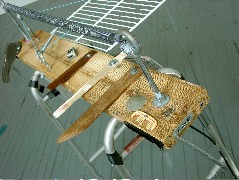
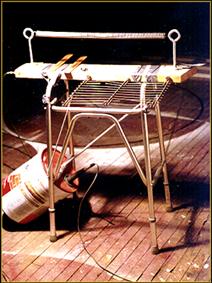
Parts of a Springboard
- coil springs of various sizes
- combs
- tuned wood slats (ala Hans Reichel’s Daxophone)
- small metal grill
- large rubber bands
… all of which are bowed, plucked, rubbed or struck with brushes, chopsticks, friction mallets, or my bare fingers. With higher amplification the entire instrument is sensitive enough to pick up sounds of the room itself. I also amplify objects placed directly on it, such as a music box mechanism, large rubber bands, a vibrating massager, and a small piezo disk speaker connected to the earphone jack of a pocket radio.
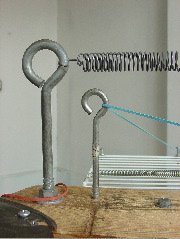
Coil springs produce a lot of enharmonic content, especially when bowed. In other words, instead of a single clearly pitched tone it produces a group or agglomeration of pitches that are not harmonically related, such as a bell. Some listeners may note its “cold” or “haunting” tone. Others will associate it with “industrial” sounds. These interpretations are subjective, and to some degree learned through Hollywood’s conventional use of such sound in film music and sound design, especially in the “Horror” and “Suspense” genres.
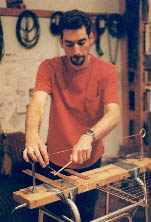
My techniques for playing the Springboard continue to develop through practice. As a drummer I learned how to become sensitive to the material response of the Springboard. I seldom ever hit any parts of the instrument as one hits a drum. Instead, bows, brushes, friction mallets, chopsticks, my bare hands and fingers apply controlled pressure, flexion, and friction to produce its most intriguing sounds. As I mentioned, I prefer using a cello bow on coil springs rather than a plucking or striking them. As with a stringed instrument, bowing produces a harmonically richer tone than plucking a string. The same applies for bowed coil springs. With large rubber bands stretched around the eyebolts and grill, I make sounds that are identical in range and timbre to an acoustic bass. I pluck them or use chopsticks to drum on them.
In 1999 I began using an Oberheim Echoplex Digital Pro to sample, loop, and overdub sounds in real-time for my performances, both solo and with the Plasticene theater company. However, in free improvised ensemble performances I prefer to use the Springboard without the Echoplex. In these situations the musical flow will shift, halt, or reverse directions faster than I can respond to them with the Echoplex .
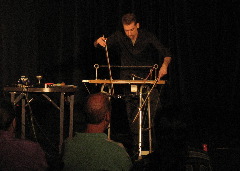
Where you place and mount the piezo will make some difference in determining sound quality. When designing a new experimental instruments my general rule of thumb is to place it in a place located near the source of the vibration. However, with the Springboard vibrations are conducted into the board from many locations. In this case, one cannot get far by obsessing about the “perfect” point. I do like having the pickup embedded in the board, away from anyplace where it may be directly struck while playing and producing an extremely loud sound relative to the others. This means the pickup is permanently mounted after many exploratory listening tests to find what sounds best. I also take care to avoid placing it where it could be damaged accidentally while playing, setting up and striking, packing and transit, including on the road, in flight luggage, etc.
Important Notes About Piezo Electric Contact Microphones
A final, important technical note about piezo electric contact microphones concerns impedance. This is essential for getting a good sound especially in the lower frequency range. Piezo electric elements are ultra-high impedance devices. Measured in Ohms signified by the omega symbol Ω, or the letter “Z”, microphones and instruments are either “high Z” or “low Z”. The inputs and outputs of mixers and amplifier have their particular impedances. If there is a mismatch between the inputs and outputs, for example, plugging a bass guitar into a mic input can result in a “thin” or “quacky” sound quality. The impedance mismatch typically results in a loss of low frequencies.
To fix this, a preamp is necessary. An EQ to boost the bass is not optimal because this can diminish the middle and upper frequencies needed in upper harmonics when needed. I recommend visiting the K&K Pickups 101 FAQ page with audio examples to understand impedance matching.
If you are comfortable with electronics, a DIY preamp can be a significant improvement. Try Richard Lerman’s schematics or the similar circuit in Nicolas Collins’s Handmade Electronic Music: The Art of Hardware Hacking. Zack Poff’s phantom-powered piezo preamp circuit designed by Alex Rice, with PCB layout for balanced output may also be useful.
Along with the preamp, it is wise to avoid long cable runs with piezo pickups, as that can increase impedance too. Bart Hopkin’s book, Getting A Bigger Sound mentions this advice. I recommend his book as it is offers many more useful ideas and resources on making and using piezo and other kinds of pickups.
Send me a message when you have made your own, please and … Enjoy!
Publications & Press
- “The Springboard: The Joy of Piezo Disk Pickups for Amplified Coil Springs,” Leonardo Music Journal Vol. 17, MIT Press, (November 2007)
- “Handheld Audio Art Devices,” Leonardson, E. (2010, June). CEC: Canadian Electroacoustic Community.
- “Instruments of Tension: Gramophones, Springs and the Performance of Place,” co-written with Jay Needham, Leonardo Music Journal, Vol. 23, MIT Press, (November/December 2013)
- “Between Air and Electricity | Microphones and Loudspeakers As Instruments,” Eck, C. (2019, April 07). The Springboard by Eric Leonardson.